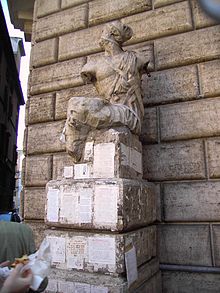Talking statues of Rome

The talking statues of Rome (
poems or witticisms were posted on well-known statues in Rome, as an early instance of bulletin board. It began in the 16th century
and continues to the present day.
In addition to
Il Babuino, and Il Facchino.[1]
History
Musei Capitolini
The first talking statue was that of
Saint Mark.[3]
Some sources suggest that the first postings were little more than schoolboys taunting their teachers, but the statues quickly became a major outlet for critiquing government and religious leaders.[4] Pasquino became so famous that his name was turned into an English word, pasquinade, which means a satirical protest in poetry.[3]
A number of popes, who were often the butt of criticism from the statues, sought to limit the posting of commentary on Pasquino.
Tiber River, and was only dissuaded when told that, like a frog, the statue would only croak louder in water.[2] Another potentially apocryphal story has a reward being offered to the anonymous writers if they came forward. According to the tale, one man responded, and his hands were cut off.[4] Eventually, the authorities settled for posting guards by the statue to prevent the posting of more commentary. As a result, the public turned to other statues, who joined Pasquino as talking statues.[1]
These other statues included Marforio, which was sometimes used to post responses to writings posted on Pasquino, creating a repartee between the two statues.[2][4]
Gallery
-
Detail of modern pasquinades glued to the base of Pasquino
-
Sant'Atanasio dei Greci
See also
Wikimedia Commons has media related to Talking statues of Rome.
- Scior Carera, a talking statue in Milan
References
- ^ a b c Piperno, Roberto. "The Talking Statues of Rome". Retrieved 2009-10-20.
- ^ ISBN 0-7867-1749-1.
talking statues of rome.
- ^ ISBN 0-19-288003-9.
rome talking statues.
- ^ ISBN 0-312-13112-7.





